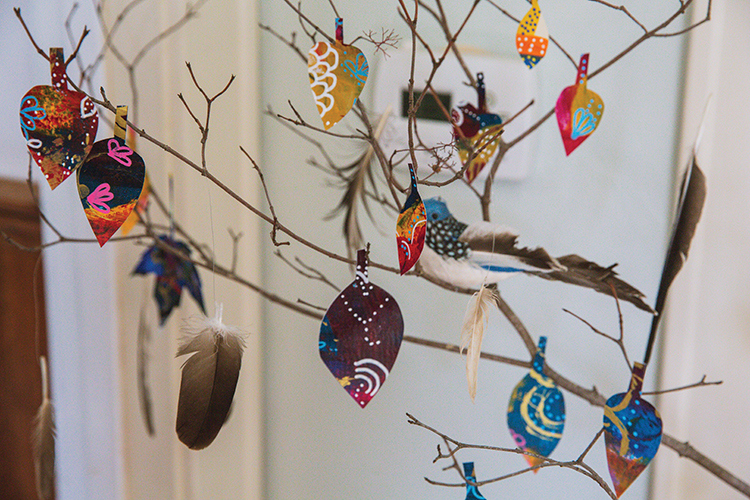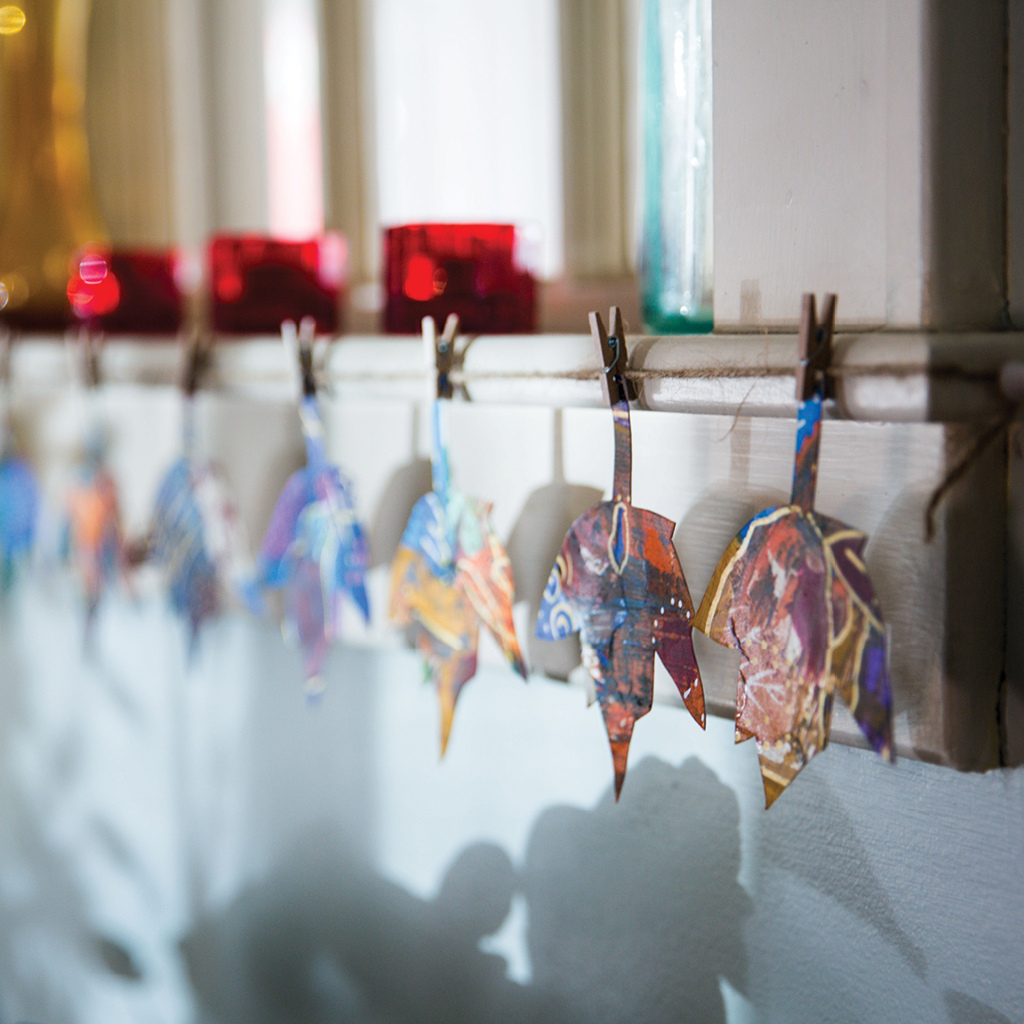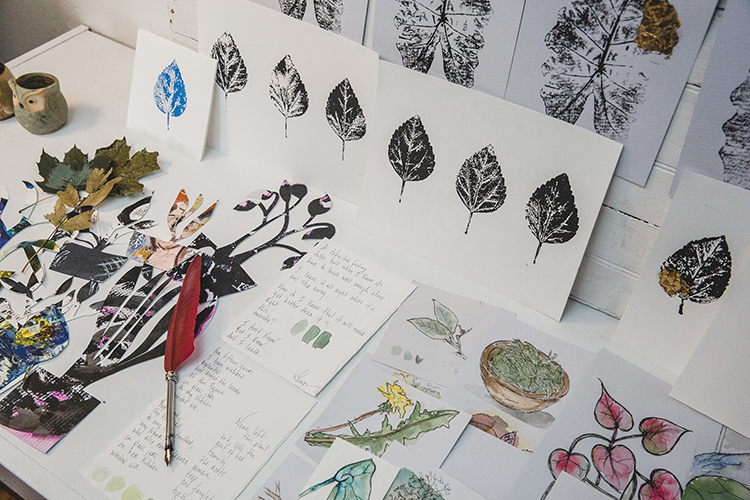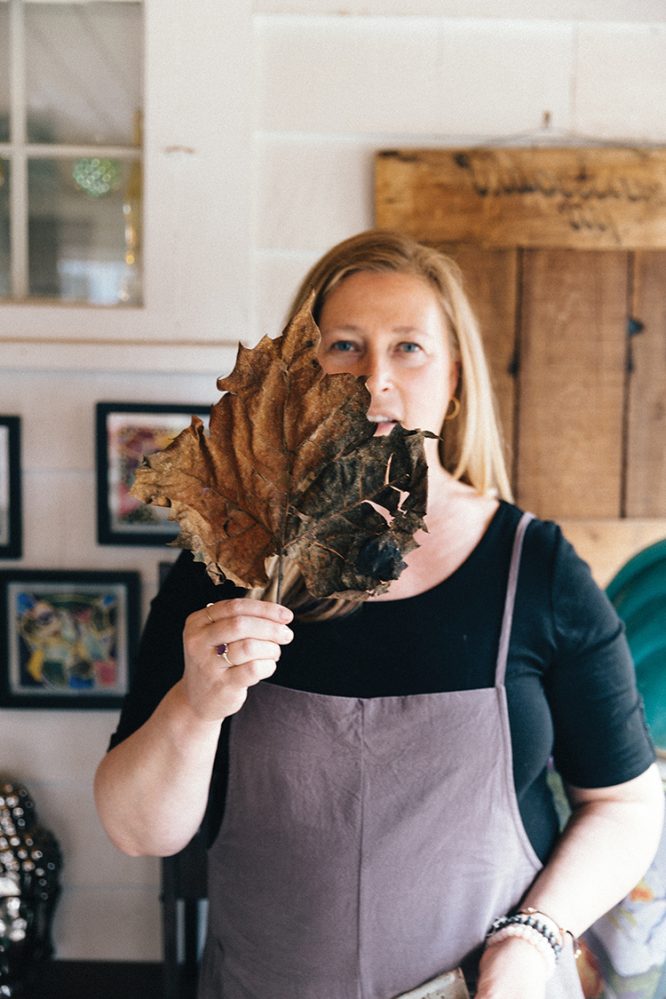
I love everything about books. With all that’s inside of them — the things I can learn, the places I can travel to, the characters I can fall in love with — what’s not to love? I love reading books; I love collecting books; and, for as long as I can remember, I have loved making books. When I was a child, the books I made were handwritten on loose-leaf paper and bound with whatever I could find: yarn, string or what I could gather from my mother’s sewing kit.
“Please, no matter how we advance technologically, please don’t abandon the book. There is nothing in our material world more beautiful than the book.”
— Patti Smith
In the fall, I loved collecting the vibrantly colored maple leaves found in my home of upstate New York. The yellow, orange and red shades would fade as I ironed them between pieces of waxed paper, complemented by the dried flowers that I had flattened between encyclopedia pages, but they remained beautiful and told the story of my day. I’m so grateful that I was a child of the ’70s, sent out to play for the day after a bowl of oatmeal and an episode of Captain Kangaroo, not needing to come home until the streetlights came on or we got hungry. Those were easy, carefree days.
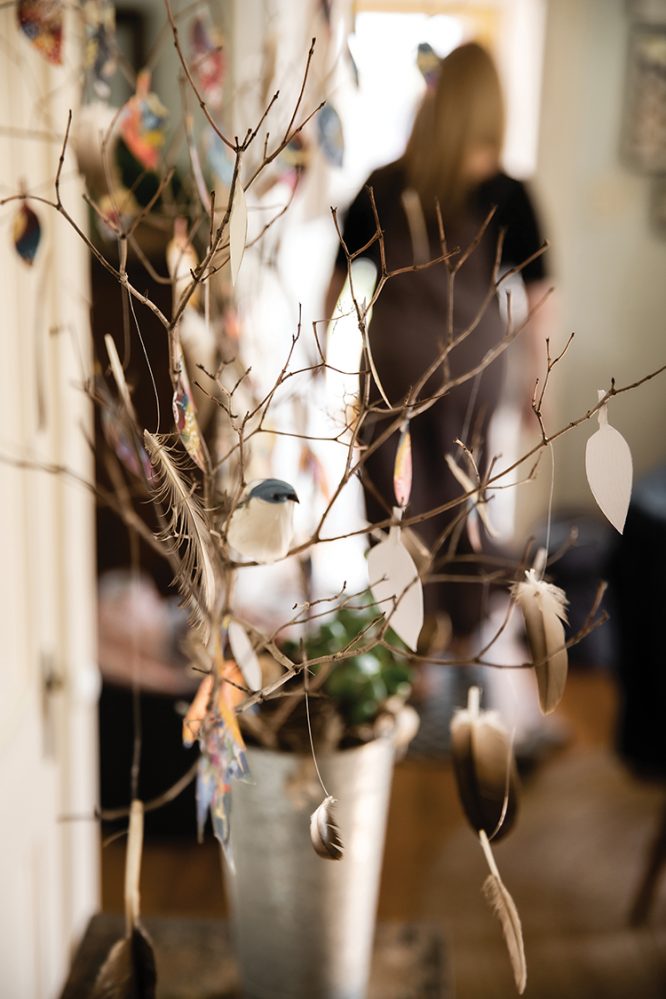
I tried playing sports like other kids in our neighborhood but, to be honest, I was awful. My first instinct was (and still is, to this day) to duck if a ball was tossed in my direction. Instead, I found my joy while exploring the woods around our neighborhood. I picked up rocks, feathers, fallen nuts, bug parts and anything else that looked interesting, coming home with pockets full of the treasures I’d found.
Nature still inspires me; I get most of my inspiration for art projects and writings while out walking or hiking with our golden retriever, Jazzy. I need that time to myself — no phone, no dishes to wash — just me, the dog and the sounds and peaceful stillness that can only be found in nature. And guess what? I still come home from walks with the dog with pockets full of treasures, all these years later, and I surround myself with them in my studio. There is so much beauty, simplicity and artistic inspiration in my nature collections.
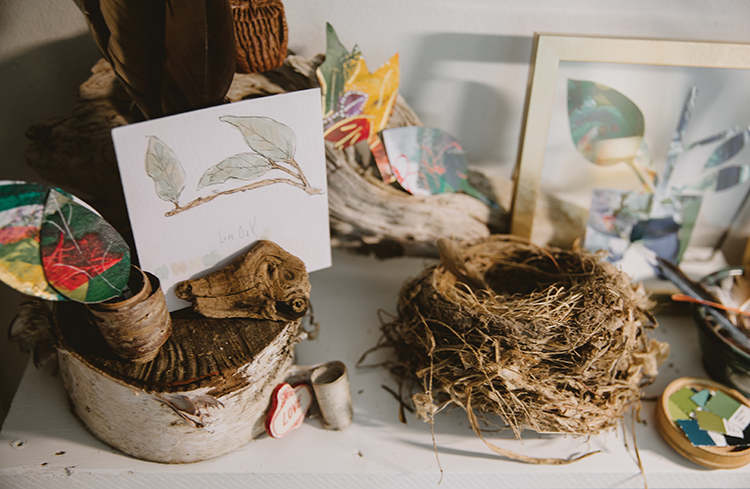
My books One Hundred Birds Telling One Hundred Little Stories and Letters to Lily, along with my forthcoming book The Art of Leaving, were created while participating in the 100 Day Project. I love art challenges, especially the 100 Day Project, which was originally a graduate school project created by designer Michael Bierut. In 2014, Elle Luna and a group of friends brought the concept to Instagram, and it has since become an annual global art project for creatives that takes place online.
The 100 Day Project takes place once a year, beginning in February, and for 100 days, thousands of people from around the world commit to 100 days of creating. What I like most is that it’s simple: choose a project (you can paint, draw, write, dance or do whatever creative project you want), announce it on Instagram (or Facebook if you use that social platform), do it every day for 100 days. Each artist posts their daily progress to their own Instagram page using the hashtag #The100DayProject.

When I think of an idea for a project and commit to working on it for 100 days, a world of new ideas opens up, and my projects twist and turn in ways that I could never imagine. I’m sure you would feel the same way. If you are interested in finding out more about the 100 Day Project, go to their website, www.the100dayproject.org, or follow them on Instagram: DoThe100DayProject.
One hundred straight days of sketching and writing is a big commitment. So far, I have never missed a day. My goal is never perfection during the 100 days; it is simply to create a piece of art and bit of writing every day. At the end, I lay it all out and see what I’ve got. The key to successfully completing the 100 days for me is getting myself very organized before I start.
I make sure I have all the supplies I will need for 100 days, right down to counting out 100 pieces of paper. I leave everything out in my studio so that in the morning, I just have to grab a cup of coffee and sit down to paint and write. If I am traveling or out of my studio for the day, I keep a to-go project bag in my backpack that contains everything I need: watercolor pens, paper and a small palette of watercolors. The sketches never take more than 20 to 30 minutes to create, and the writing can take 15 minutes to an hour depending on what I am working on.
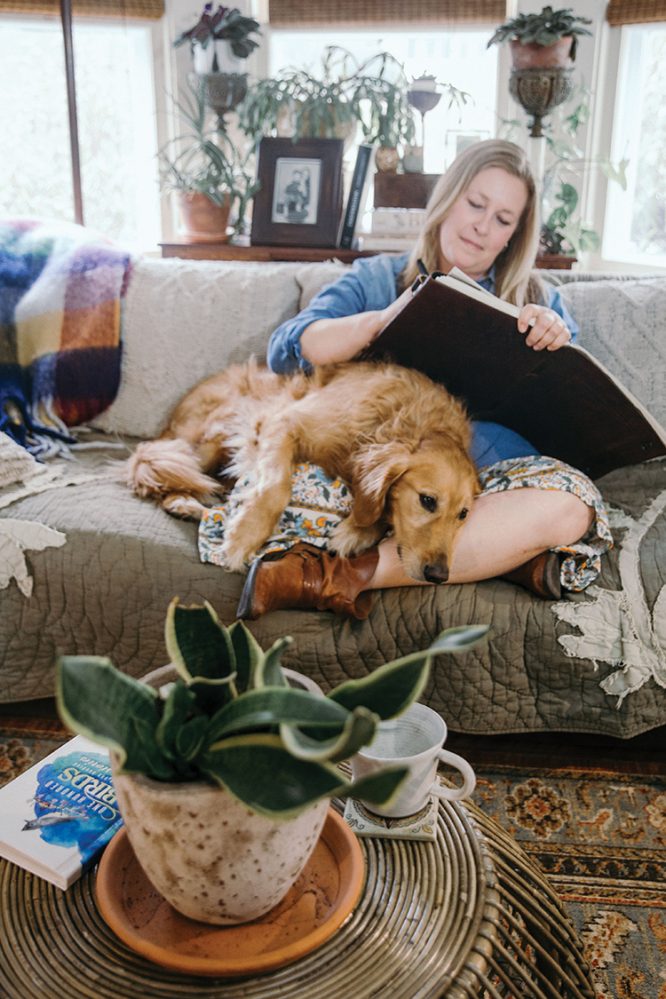
I often get asked: “What comes first, the words or the art?” For me, each day is different. When I am stuck with writing, I sketch or paint. And on the flip side, if I need to step away from a work of art I’m creating, I write. Both mediums build off each other in such a way that I don’t think I could do one without the other. I see words and stories in my paintings the same way that I see the characters and pictures of the words that I am writing.
At the end of the day, the most important part of the process is showing up every day in the studio with an open mind and heart. And on the days when I look at something I wrote or painted and like it, well, it’s the best feeling in the world.
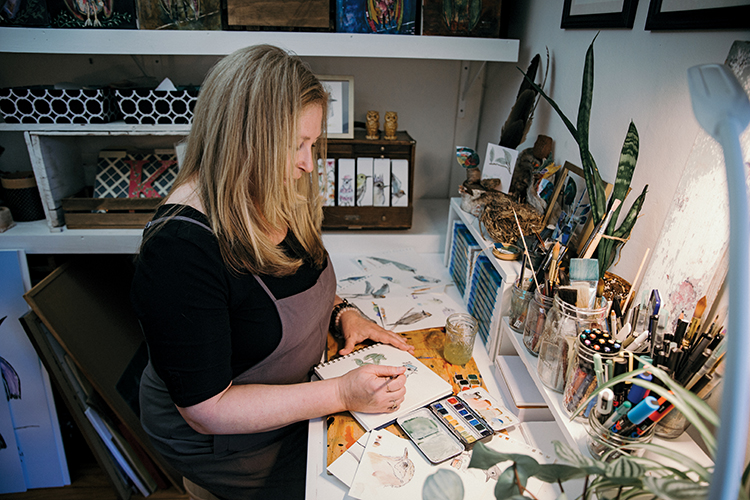
Like most people, my day-to-day living is busy. When my daughter was young, I would often go to bed wishing I had more time to devote to my creative work. I had so many ideas for projects but felt like I lacked the time to bring them to life. But be careful what you wish for: I broke my leg when she was in high school and spent months recuperating in a recliner in our living room. Everything stopped. I suddenly had nothing but time.
“Almost everything will work again if you unplug it for a few minutes, including you.”
— Anne Lamott
Something good did come from that time, though. While sitting there, I noticed the same birds coming to the feeder day after day, inspiring me to sketch their cute little faces. And then I began wondering what they were thinking of — they always looked like they had something on their mind — and I took notes and wrote silly poems. The sketches evolved; soon, the whimsical little birds were coming to life on paper, wearing funny clothes and hats. That was the beginning of One Hundred Birds Telling One Hundred Little Stories, and it was the first year I participated in the 100 Day Project (2019).
The intention wasn’t to create a book at the end. I did it to explore a quicker, more sketchy style of doing watercolors and to commit to writing a bit every day. It was about three-quarters of the way through the One Hundred Birds project when I started to see that there might be enough art and stories to compile all of the pieces to make a book. So, I did, and it was a turning point in my creative life and process.
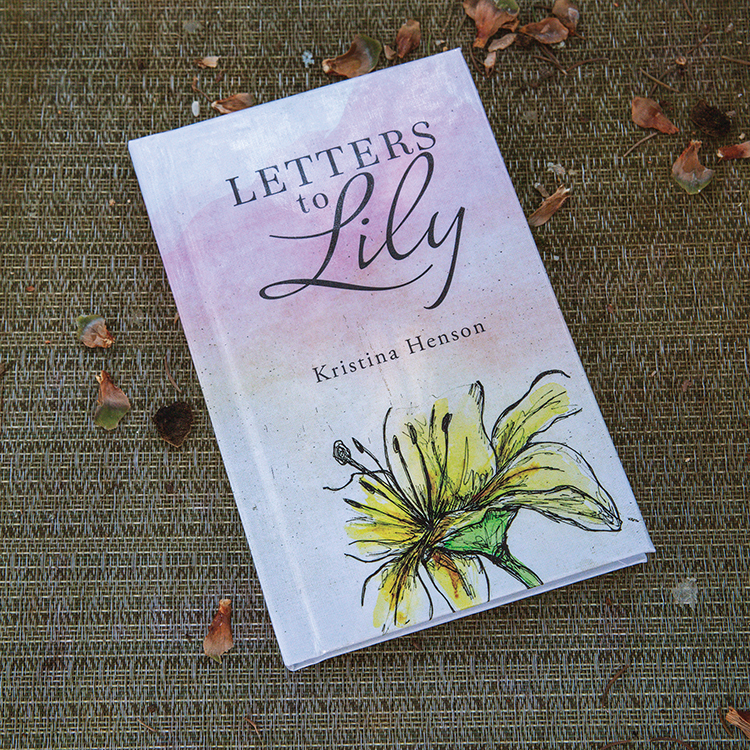
The following year, my 100 Day Project was called Letters to Lily. My daughter, Lily, was starting college, and for the 100 days of the project, I sketched and painted a lily flower in watercolor and wrote a poem or letter to my daughter. The difference with my approach to the Letters to Lily project and the One Hundred Birds project was that I wanted Letters to Lily to be another book. I LOVED turning the One Hundred Birds project into a beautiful hardcover book. The same was true for The Art of Leaving. I started that 100 Day Project hoping that at the end, I would have a volume of work that I could make into another book. And again, I do!
The concept for The Art of Leaving was to merge the definition of the word “leaves” as a noun and verb. I set out to paint leaves and write a page of poetry or an essay every day for 100 days. I thought the illustration style would be similar to that of One Hundred Birds — but it didn’t turn out that way. That’s one of the things I love the most about the 100 Day Project; I start with one idea and am always surprised with what I have created at the end of the 100 days.
During the 100 days of The Art of Leaving, my natural curiosity and versatility led me down the path of exploring so many different mediums: watercolor, mixed media, printmaking and collages. As I am beginning the production and bookmaking part of The Art of Leaving, I am remembering the joy of pulling relief prints and filling up the walls of my studio with the maple and oak leaves I cut out from larger pieces of mixed-media art. The possibilities for the project seemed endless. I couldn’t stop after the 100 days. I’m still making leaves!
The Art of Leaving isn’t published (yet) but will be soon. I have 100 pieces of art and a poem or essay that goes with each. Now I am in the process of laying out the pages of the book, editing and designing the cover. It will have the same lighthearted, eclectic mix of poetry and short stories that have become my signature style. Readers seem to enjoy that the books themselves are also a piece of art; they can be left out on a coffee table, having been designed to be read when you have a few minutes and want a quick escape from demands of the day. My background in graphic design and graphic production provided me with the skills I needed to design and self-publish the One Hundred Birds book, and I plan to do the same with The Art of Leaving. While I know that it’s not the path for everyone, for me, I felt like I had all the skills I needed to bring my vision for the books to life. I wanted to select the paper and the hardcover, and knew I wanted everything to print in the United States.
My biggest challenge was (and still is) having the time to do all of this. When my daughter was young, I was happy to put my creative projects on the back burner in order to spend as much time as possible with her. But now that she is more independent, I never want “lack of time” to be a reason not to create.

There’s a bit of magic in the morning before the birds wake up and sunlight starts to filter in, and I never want to miss it. So, I get up very early and write and work on a piece of art before the busyness of the day begins. Do a lot of things end up in the trash? Sure thing. But more often than not, I find that taking those 20 to 30 minutes in the wee hours of the morning to make art or write a bit opens up the door to beautiful surprises throughout the rest of the day.
I can define myself by being so many things: a mother, a daughter, a sister, an artist, an author, a designer. But most importantly — and what I remind myself of often — is that I am a woman who needs to create. Is self-publishing for everyone? Probably not. But it’s the right vehicle for me to bring my characters and stories to life.
I hope that everyone reading through the pages feels the joy I felt while making them. Everything I have ever dreamed of creating is in between the covers of these books.

I love everything about books. With all that’s inside of them — the things I can learn, the places I can travel to, the characters I can fall in love with — what’s not to love? I love reading books; I love collecting books; and, for as long as I can remember, I have loved making books. When I was a child, the books I made were handwritten on loose-leaf paper and bound with whatever I could find: yarn, string or what I could gather from my mother’s sewing kit.
“Please, no matter how we advance technologically, please don’t abandon the book. There is nothing in our material world more beautiful than the book.”
— Patti Smith
In the fall, I loved collecting the vibrantly colored maple leaves found in my home of upstate New York. The yellow, orange and red shades would fade as I ironed them between pieces of waxed paper, complemented by the dried flowers that I had flattened between encyclopedia pages, but they remained beautiful and told the story of my day. I’m so grateful that I was a child of the ’70s, sent out to play for the day after a bowl of oatmeal and an episode of Captain Kangaroo, not needing to come home until the streetlights came on or we got hungry. Those were easy, carefree days.

I tried playing sports like other kids in our neighborhood but, to be honest, I was awful. My first instinct was (and still is, to this day) to duck if a ball was tossed in my direction. Instead, I found my joy while exploring the woods around our neighborhood. I picked up rocks, feathers, fallen nuts, bug parts and anything else that looked interesting, coming home with pockets full of the treasures I’d found.
Nature still inspires me; I get most of my inspiration for art projects and writings while out walking or hiking with our golden retriever, Jazzy. I need that time to myself — no phone, no dishes to wash — just me, the dog and the sounds and peaceful stillness that can only be found in nature. And guess what? I still come home from walks with the dog with pockets full of treasures, all these years later, and I surround myself with them in my studio. There is so much beauty, simplicity and artistic inspiration in my nature collections.

My books One Hundred Birds Telling One Hundred Little Stories and Letters to Lily, along with my forthcoming book The Art of Leaving, were created while participating in the 100 Day Project. I love art challenges, especially the 100 Day Project, which was originally a graduate school project created by designer Michael Bierut. In 2014, Elle Luna and a group of friends brought the concept to Instagram, and it has since become an annual global art project for creatives that takes place online.
The 100 Day Project takes place once a year, beginning in February, and for 100 days, thousands of people from around the world commit to 100 days of creating. What I like most is that it’s simple: choose a project (you can paint, draw, write, dance or do whatever creative project you want), announce it on Instagram (or Facebook if you use that social platform), do it every day for 100 days. Each artist posts their daily progress to their own Instagram page using the hashtag #The100DayProject.

When I think of an idea for a project and commit to working on it for 100 days, a world of new ideas opens up, and my projects twist and turn in ways that I could never imagine. I’m sure you would feel the same way. If you are interested in finding out more about the 100 Day Project, go to their website, www.the100dayproject.org, or follow them on Instagram: DoThe100DayProject.
One hundred straight days of sketching and writing is a big commitment. So far, I have never missed a day. My goal is never perfection during the 100 days; it is simply to create a piece of art and bit of writing every day. At the end, I lay it all out and see what I’ve got. The key to successfully completing the 100 days for me is getting myself very organized before I start.
I make sure I have all the supplies I will need for 100 days, right down to counting out 100 pieces of paper. I leave everything out in my studio so that in the morning, I just have to grab a cup of coffee and sit down to paint and write. If I am traveling or out of my studio for the day, I keep a to-go project bag in my backpack that contains everything I need: watercolor pens, paper and a small palette of watercolors. The sketches never take more than 20 to 30 minutes to create, and the writing can take 15 minutes to an hour depending on what I am working on.

I often get asked: “What comes first, the words or the art?” For me, each day is different. When I am stuck with writing, I sketch or paint. And on the flip side, if I need to step away from a work of art I’m creating, I write. Both mediums build off each other in such a way that I don’t think I could do one without the other. I see words and stories in my paintings the same way that I see the characters and pictures of the words that I am writing.
At the end of the day, the most important part of the process is showing up every day in the studio with an open mind and heart. And on the days when I look at something I wrote or painted and like it, well, it’s the best feeling in the world.

Like most people, my day-to-day living is busy. When my daughter was young, I would often go to bed wishing I had more time to devote to my creative work. I had so many ideas for projects but felt like I lacked the time to bring them to life. But be careful what you wish for: I broke my leg when she was in high school and spent months recuperating in a recliner in our living room. Everything stopped. I suddenly had nothing but time.
“Almost everything will work again if you unplug it for a few minutes, including you.”
— Anne Lamott
Something good did come from that time, though. While sitting there, I noticed the same birds coming to the feeder day after day, inspiring me to sketch their cute little faces. And then I began wondering what they were thinking of — they always looked like they had something on their mind — and I took notes and wrote silly poems. The sketches evolved; soon, the whimsical little birds were coming to life on paper, wearing funny clothes and hats. That was the beginning of One Hundred Birds Telling One Hundred Little Stories, and it was the first year I participated in the 100 Day Project (2019).
The intention wasn’t to create a book at the end. I did it to explore a quicker, more sketchy style of doing watercolors and to commit to writing a bit every day. It was about three-quarters of the way through the One Hundred Birds project when I started to see that there might be enough art and stories to compile all of the pieces to make a book. So, I did, and it was a turning point in my creative life and process.

The following year, my 100 Day Project was called Letters to Lily. My daughter, Lily, was starting college, and for the 100 days of the project, I sketched and painted a lily flower in watercolor and wrote a poem or letter to my daughter. The difference with my approach to the Letters to Lily project and the One Hundred Birds project was that I wanted Letters to Lily to be another book. I LOVED turning the One Hundred Birds project into a beautiful hardcover book. The same was true for The Art of Leaving. I started that 100 Day Project hoping that at the end, I would have a volume of work that I could make into another book. And again, I do!
The concept for The Art of Leaving was to merge the definition of the word “leaves” as a noun and verb. I set out to paint leaves and write a page of poetry or an essay every day for 100 days. I thought the illustration style would be similar to that of One Hundred Birds — but it didn’t turn out that way. That’s one of the things I love the most about the 100 Day Project; I start with one idea and am always surprised with what I have created at the end of the 100 days.
During the 100 days of The Art of Leaving, my natural curiosity and versatility led me down the path of exploring so many different mediums: watercolor, mixed media, printmaking and collages. As I am beginning the production and bookmaking part of The Art of Leaving, I am remembering the joy of pulling relief prints and filling up the walls of my studio with the maple and oak leaves I cut out from larger pieces of mixed-media art. The possibilities for the project seemed endless. I couldn’t stop after the 100 days. I’m still making leaves!
The Art of Leaving isn’t published (yet) but will be soon. I have 100 pieces of art and a poem or essay that goes with each. Now I am in the process of laying out the pages of the book, editing and designing the cover. It will have the same lighthearted, eclectic mix of poetry and short stories that have become my signature style. Readers seem to enjoy that the books themselves are also a piece of art; they can be left out on a coffee table, having been designed to be read when you have a few minutes and want a quick escape from demands of the day. My background in graphic design and graphic production provided me with the skills I needed to design and self-publish the One Hundred Birds book, and I plan to do the same with The Art of Leaving. While I know that it’s not the path for everyone, for me, I felt like I had all the skills I needed to bring my vision for the books to life. I wanted to select the paper and the hardcover, and knew I wanted everything to print in the United States.
My biggest challenge was (and still is) having the time to do all of this. When my daughter was young, I was happy to put my creative projects on the back burner in order to spend as much time as possible with her. But now that she is more independent, I never want “lack of time” to be a reason not to create.

There’s a bit of magic in the morning before the birds wake up and sunlight starts to filter in, and I never want to miss it. So, I get up very early and write and work on a piece of art before the busyness of the day begins. Do a lot of things end up in the trash? Sure thing. But more often than not, I find that taking those 20 to 30 minutes in the wee hours of the morning to make art or write a bit opens up the door to beautiful surprises throughout the rest of the day.
I can define myself by being so many things: a mother, a daughter, a sister, an artist, an author, a designer. But most importantly — and what I remind myself of often — is that I am a woman who needs to create. Is self-publishing for everyone? Probably not. But it’s the right vehicle for me to bring my characters and stories to life.
I hope that everyone reading through the pages feels the joy I felt while making them. Everything I have ever dreamed of creating is in between the covers of these books.









